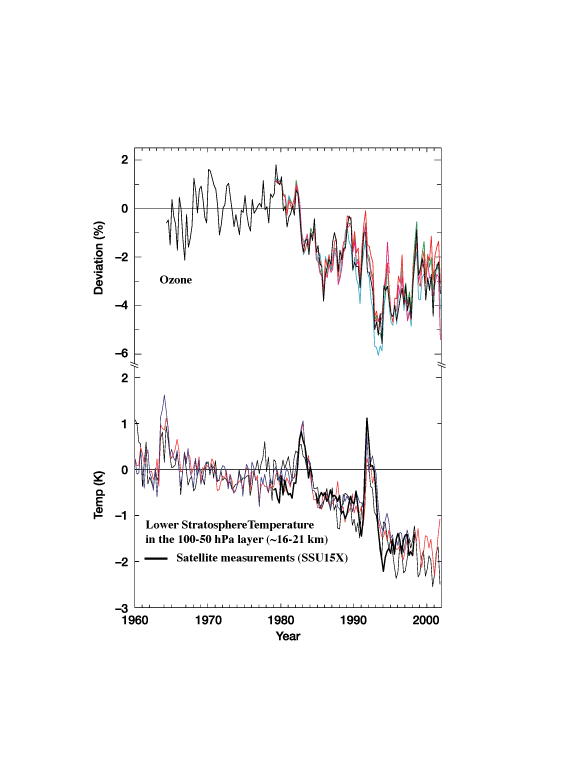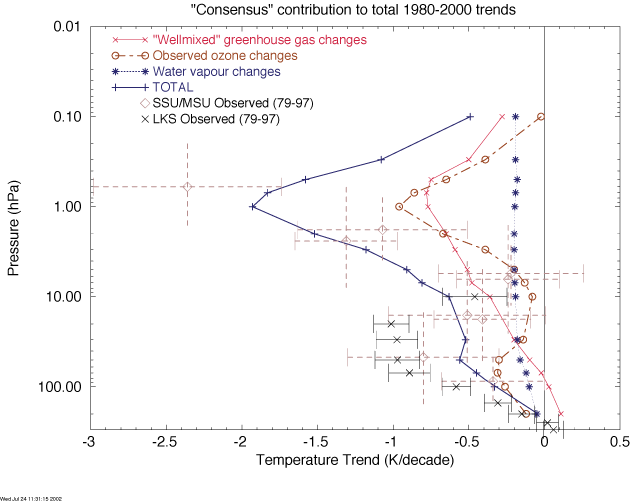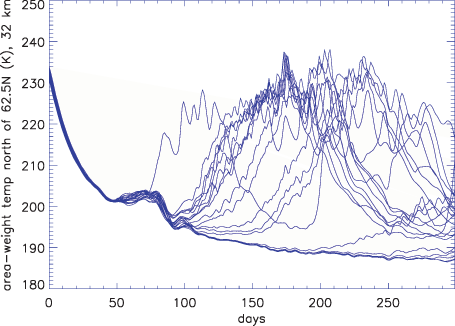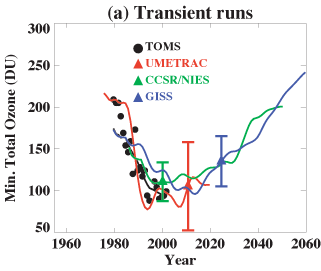SPARC
Stratospheric Processes And their Role in Climate
A core project of the World Climate Research Programme
Detection, Attribution, and Prediction of Stratospheric Change
How well can we explain past changes in terms of natural and anthropogenic effects?
How do we expect the stratosphere to evolve in the future, and what confidence do we have in those predictions?
Theme leaders: W. Randel (USA), T.G. Shepherd (Canada)
The composition and circulation of the stratosphere has changed substantially during the past four decades, and these changes have had a sizeable impact on the global climate system. Reliable observational records for global stratospheric ozone and lower stratospheric temperature, which extend back to the late 1950’s, show significant changes during the most recent decades (Figure 1). Stratospheric changes occur as a result of both natural and anthropogenic causes, for example by volcanic or solar cycle effects, and by variations in greenhouse gases and ozone depleting substances. The stratosphere also exhibits substantial unforced natural variability, which is not well quantified. In order to predict the future evolution of the stratosphere, and quantify uncertainties in such predictions, it is important to understand past stratospheric changes, and in particular develop global models capable of simulating the observed record within the natural variability. Detection and attribution of past stratospheric changes go hand-in-hand with developing an ability to predict future evolution.
 |
Figure 1. Time series of globally averaged changes in column ozone (top) and lower stratospheric temperatures (bottom) for the period 1960-2000. The ozone observations show results derived from a number of ground-based and satellite data sets, from Fioletov et al. (2002); the light lines show results derived from several radiosonde data sets (described in Seidel et al., 2004). Both the ozone and temperature time series have been deseasonalized and changes are expressed with respect to a reference period of 1960-1980. For better resolution, please contact the SPARC Office |
Past activities of SPARC have focused on quantifying the historical variations (and uncertainties) in stratospheric ozone, temperature, water vapour and aerosols, and ongoing work is aimed at assuring continued high quality ‘climate’ temperature data sets for the stratosphere. A key question is how the temperature and constituent observations fit together within the current understanding of the stratospheric climate system. This question is addressed by comparing past observations with a hierarchy of model simulations of varying complexity. For example, in a globally and seasonally averaged sense (which substantially reduces the effects of natural variability),the observed vertical structure of decadal stratospheric cooling over 1980-2000 is in reasonable agreement with changes calculated from decreasing ozone and increasing greenhouse gases (Figure 2).
 |
Figure 2. Global and annual mean temperature trends for the period approximately 1980-2000, from an average of model results using observed changes in ozone and greenhouse gases, and idealized water vapour trends. Observed temperature trends derived from satellite and radiosonde data sets are indicated by the symbols, and the error bars give the two-sigma trend uncertainties (from Shine et al., 2003). For better resolution, please contact the SPARC Office |
However, more detailed comparisons show that the magnitude of the observed cooling in the Northern Hemisphere extratropical lower stratosphere is much larger than that calculated. This suggests that either additional processes need to be included in the model simulations (a plausible candidate is an increase in stratospheric water vapour over this time period), or the models do not properly represent the dynamical feedback to the forcing, or the observed cooling includes a large component of unforced natural variability. While examining linear trends is instructive, future attribution work will focus on simulating the full variability of the historical record, including effects such as volcanic eruptions, solar variability and stratosphere-troposphere dynamical coupling.
A key aspect of attribution is the development and refinement of global models to include more complex and realistic physical processes. The current research community involves a number of groups with General Circulation Models (GCM’s) that include a realistic middle atmosphere, and work is progressing to develop and use fully coupled chemistry-climate models. While, overall, these models have substantially improved their climate simulations with time, there are still chronic problems in many models, including persistent temperature and zonal wind biases, and a lack of realistic tropical zonal wind oscillations. The GCM-Reality Intercomparison Project for SPARC (GRIPS) is aimed at intercomparing and improving model behaviour, with current and planned topics including:
1) Comparisons of model responses to specified forcings, such as volcanic and solar cycle variability.
2) Intercomparisons of radiation codes, stratospheric transport diagnostics and winter polar ozone loss simulations.
3) Improved quantification of gravity wave parameterisation effects, sensitivities and uncertainties.
4) Better understanding of dynamical feedbacks and stratosphere-troposphere coupling.
5) Improved UTLS physics, especially aerosol and cloud microphysics.
One further aspect of understanding decadal-scale changes in stratospheric climate is the probabilistic nature of the problem. Large dynamic variability within the stratosphere (especially in winter and spring) makes the detailed evolution sensitive to initial conditions (as illustrated in Figure 3). This behaviour requires the use of ensemble runs and long control simulations to properly distinguish signal and (climate) noise for both past and future changes. It also mandates the use of multiple models, given current uncertainties in model formulations and dynamical feedbacks.
 |
Figure 3. An ensemble of time series of temperature in the middle stratosphere over the polar cap, as simulated by a numerical model of the stratosphere and mesosphere, starting from slightly different initial conditions in August. (Courtesy Lesley Gray, University of Reading). For better resolution, please contact the SPARC Office |
Figure 4 shows an example of chemistry-climate model predictions of Antarctic ozone changes to 2060 (from Austin et al., 2003). Although the models are driven by the same imposed forcing changes, there are substantial differences in both time evolution and interannual variability among the models, and the reasons for these differences are poorly understood. Evaluating the reasons for such model sensitivities (in particular for coupled chemistry-climate models) is a crucial step forward for predicting future stratospheric changes.
 |
Figure 4.Time series of minimum Antarctic total ozone from TOMS observations (for 1979-2001) and results from several 3D chemistry climate model transient simulations for the period ~1980-2050. (Details can be found in Austin et al., 2003). For better resolution, please contact the SPARC Office |
Climate-Chemistry Interactions
Stratosphere-Troposphere Dynamical Coupling
Last update : September 14, 2010
